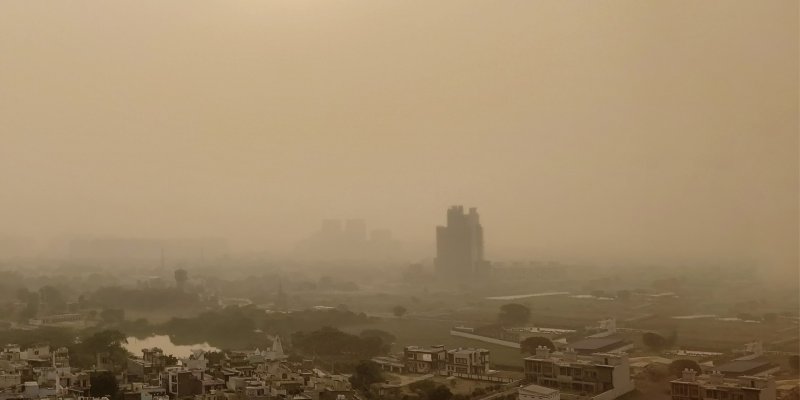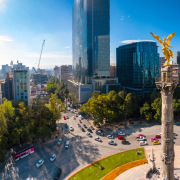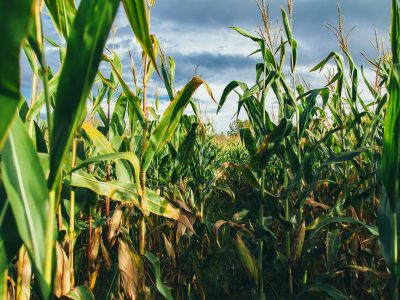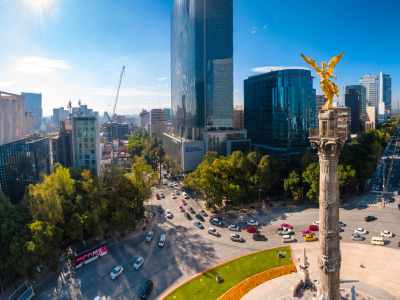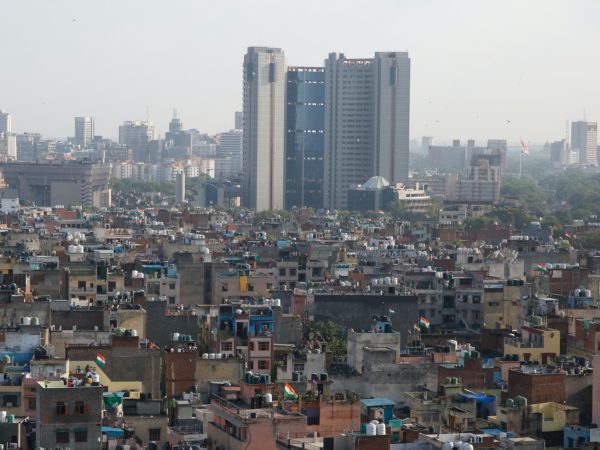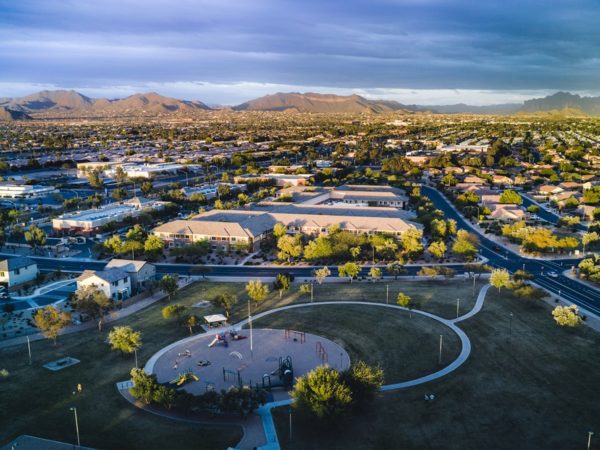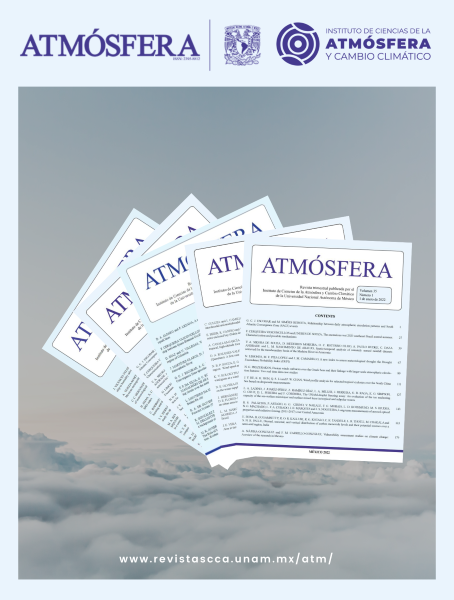Introduction
Skies over Delhi become blurred and visibility is significantly reduced and the air is hefty and causes a burning sensation in the eyes. As every year in November, a thick blanket of smog veils Delhi and its surrounding National Capital Region-NCR of India, which constitute the world’s most polluted megacity. According to a senior pulmonologist and member of the WHO commission on global air pollution and health, patients experiencing breathing problems increase by 30-40 percent every year during October-November. But Delhi’s smog wasn’t always this bad in early winter; it started only about 10-15 years ago.
Satellite images show high Aerosol Optical Depth (AOD), as soon as farmers start burning paddy straw and stubble (agri-residue) in agricultural fields, and air quality severely deteriorates. The agri-residue smoke from agricultural areas surrounding Delhi, combined with urban pollution from vehicles, industry, and fireworks from the Diwali festival, increase pollutants to the severe category. Smoke from farm fires after harvest contributed about ⁓ 26-50% of the PM2.5 (tiny particles that damage lungs and can worsen cardiac ailments) to Delhi’s air in November 2023. The average resident of this megacity is on track to lose ⁓ 8 years of life expectancy if high pollution levels persist (EPIC, 2023). Authorities in this smog-ridden capital, even imposed emergency school closures of 7 to 15 days in 2016, 2017 and 2023 to mitigate health issues in the population, who flooded emergency wards at hospitals.
Agri-residue burning
Delhi is engulfed in unpleasant smog every autumn, predominantly attributed to agri-residue burning in the neighbouring agricultural region (Punjab, Uttar Pradesh & Haryana). The huge amount of residual material (cereal straws, stubble, woody stems & leaves) generated after harvesting grains, is set ablaze by farmers to clear the lands for the next crop. Punjab alone burns ~18 million tonnes of agri-residue during this season (Singh, 2020). The thick plume sprawled across northern India, as visible on NASA satellite imagery (figure 1), indicating high AOD concentrations (dark brown), medium AOD (tan) and little AOD (light yellow). Black pixels depict non-measurable areas.

B) Agri-residue burning hotspots in surroundings of Delhi for 23 November 2023. (Courtesy NASA).
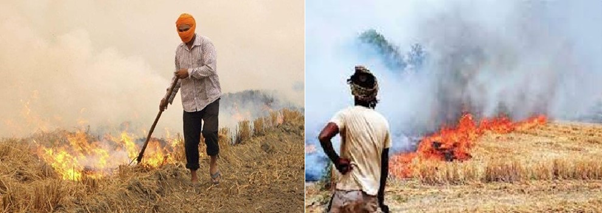
Different estimates suggest that stubble burning (figure 2) contributes 50–75% to urban PM2.5 and 40-45% to PM10 concentration between October and November. The contribution to PM2.5 concentrations in Delhi exceeded 25% on 2 November 2023 (SAFAR- Govt. of India agency), which the previous week was in the range of 10-20%. In 2021-2022 (Mid-November), farm fires contributed up to 40% to PM2.5 pollution, as per Centre of Science & Environment reports. Bikkina et al. (2019) report that 42% of the suspended particulate mass impacting air quality and health in Delhi, was from crop burning. Another study estimated that on average, 20% of PM2.5 in Delhi was from crop fires, but that could peak to 50–75% on severe days (Kulkarni et al, 2020). The combined effects of emissions, climatic factors, and land cover results in poor air quality in northern India (Bhattarai et al, 2024). A positive correlation (0.8) between PM2.5, PM10, NOX & CO and fire counts suggests a strong influence of agricultural stubble burning on air quality over Delhi.
Furthermore, the firecracker activities during the Diwali festival (typically in late October- early November) significantly increase the concentration of particulate matter with ~100% increment in PM2.5 and ~55% increment in PM10 concentrations for a relatively short period, deteriorating air quality to the severe+ category: AQI > 450 (Khan et al, 2023).
The World Air Quality Index project (WAQI, aqicn.org) reported the AQI levels in Delhi at 999 on 3 November, 2023, with levels of PM2.5 reaching 570 mg/m3 (as per IQ Air-CAQM), >40 times over the WHO guidelines (Patel, 2023). As shown in the WHO global platform for air quality and health, Delhi exceeded by 21 times the WHO guidelines on annual exposure of PM2.5 (Figure 3).
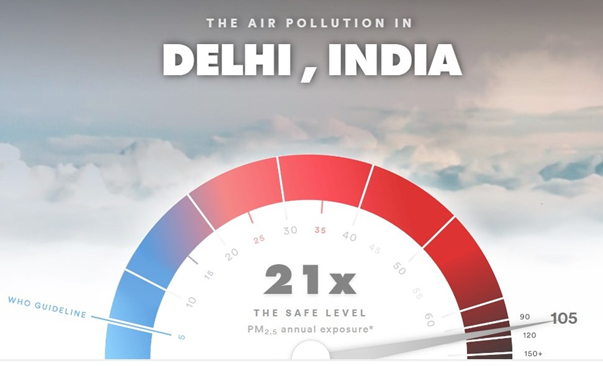
Poor air quality and health
Delhi, with nearly 30 million residents, is ranked the world’s top polluted city. It is estimated that ⁓20,000 premature deaths occur annually in Delhi NCR alone, due to poor air quality, and this amount may increase to 32,000 by 2025 and 52,000 by 2050 (OECD, 2016). The WHO assesses that air pollution is responsible for more than 7 million premature deaths per year worldwide. India tops the list of premature deaths, with over 2 million (figure 4A). Poor air quality due to agri-residue burning pollutants can lead to pulmonary and heart diseases, lung tumours, increased risks of epilepsy, cancer and diabetes, seen among children and pregnant females (Singh, 2018).
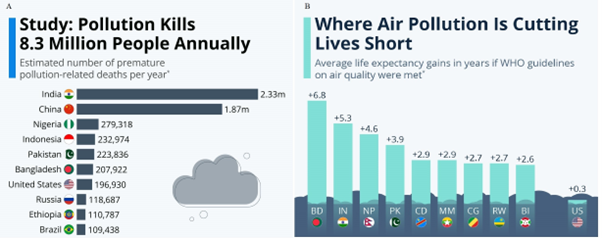
Brajer et al. (2022) found that Delhi air pollution positively increases respiratory diseases and worsen lung function in residents with breathing problems. Chowdhury et al. (2023) reported a cumulative economic cost of air pollution due to health expenses and loss of productivity in the Delhi region. Gul and Das (2023) presented a substantial inverse correlation between air pollution and people’s happiness index in Delhi.
To address SDG 3.9 (Mortality from environmental pollution) and SDG 11.6 (Clean cities), WHO encourages nations to reduce the death toll due to air pollutants and urges to improve air quality in big cities, like Delhi. The Energy Policy Institute at the University of Chicago (EPIC, 2023) indicates that poor air quality could reduce the life expectancy of Delhi residents by as much as nine years and life expectancy can be increased by >5.3 years (National) to ⁓11.9 years (Delhi) if good quality air were ensured (Figure 4B & Figure 5). According to breathlife2030.org, air pollution resulted in ⁓54,000 premature deaths in Delhi in 2020. Statistically significant results related to ambient air pollution and premature morbidity in Indian population were reported by Rajak and Chattopadhyay (2019).
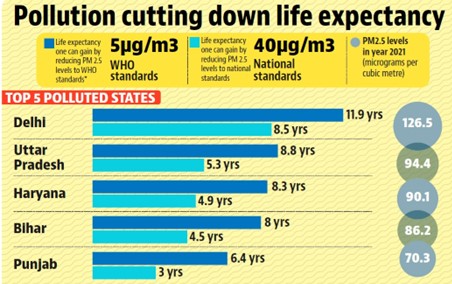
Mitigation measures
Given the large risk to human health, authorities have implemented measures to improve air quality, which according to the Commission for Air Quality Management -CAQM- have resulted in a reduction in agri-residue burning between 2018 and 2023. Some of those measured comprise:
a) The central government announced in 2019 a National Clean Air Program-NCAP, with the aim to reduce particulate pollution by up to 30% by 2024.
b) The Delhi government installed a smog tower in 2021 intended to reduce pollution through the use of air filters. Although air filters work well indoors -in confined spaces- they are not effective in open areas.
c) The Delhi government authorities, with the technical help of IIT-Kanpur, initiated a cloud seeding program to stimulate artificial rain and decrease air pollution. However, this type of action is not sustainable, since it does not address the root cause of pollution.
c) The supreme court of India (at Delhi) takes suo-moto (proactive approach) on Delhi’s deteriorated air quality and issued directions (December 2023) to NCR states to combat agri-stubble burning and comply before winter of 2024.
d) The CAQM imposed Graded Response Action Plan – GRAP-III order (Nov. 2, 2023) & GRAP-IV (Nov 5, 2023) in Delhi-NCR region and plays a vital role in controlling the air polluting activities in this region. (Note: The Graded Response Action Plan at level III limits construction and commercial activities, and bans polluting trucks. At level IV it can even impose school shutdowns due to poor air quality)
e) Punjab established thermal power stations and petroleum refineries to run on agri-residue (2 million MT annually) to mitigate the in-situ burning and provide a viable alternative to farmers.
f) The Indian Agricultural Research Institute (IARI) developed a bio-enzyme based decomposer for amalgamating residue in soils. The government is providing incentives to farmers for not burning straw in fields, and provides subsidized machinery (Rotavator, Chopper, Baler & Happy Seeder) for better management of paddy straw in situ.
g) Some other viable solutions to mitigate burning includes agri-residue conversion to compact rolls for commercial biomass, pellets/ briquettes formation, straw-stubble utilization in biogas plant, thermal plant feeding material (figure 6).
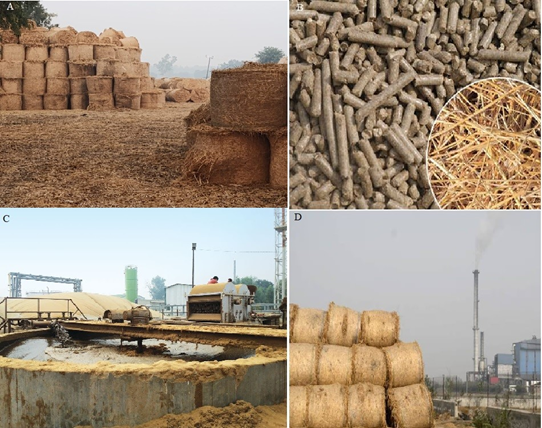
The satellite monitoring division of IARI has reported 35,350 crop residue burning events in 2023, 65% of which occurred in Punjab state. So far 23,620 events – the lowest in four years have been reported (Sept -Nov., 2023) from the state, compared to 34,868 (2022) and 69,372 in 2020. Haryana has only reported 1,676 events (2023), down from 2,693 (2022) and much lower than the 4,753 in 2020. Thus significant reduction in burning events were observed due to authority’s efforts and public awareness in these states surrounding Delhi.
Conclusion
Although various legislative and control steps have been implemented by the pollution control authorities of India, the menace of in situ agri-residue burning continues to seriously deteriorate air quality and result in health complications in the area, – a matter of critical concern.
Restraints on industrial, commercial, transportation, and other activities during the COVID-induced lockdown period had a positive impact on air quality in metropolitan Delhi (Singh 2020), clearly attributing the poor air quality to vehicular emissions and agri-residue burning (Singh, 2018). Hence other commercial activities also need to be addressed.
Besides traditional uses for crop residue such as fuel materials, composting, cattle fodder and bedding, and soil-mulching, its use as power plant fuel, mushroom farming material, bio-lubricants extraction, paper-pulp manufacturing and biogas generation, can be incorporated into a plan to provide alternatives to stubble and straw burning.
More widespread knowledge regarding ill-impacts of agri-residue burning along with its alternative usage to gain economic benefits can bring sustainable results. To contribute to Sustainable Development Goals-SDG (3.9; 7.2; 11.2; 11.6 & 13) and targets of the Paris agreement and COP-28, grassroot actions and sustainable approaches for agri-residue management need to be adopted.
Acknowledgments
The author extends his heartfelt thanks to the WHO, NASA, CPCB, CAQM, IARI and other data providing agencies for the ambient air quality data used in this article.
References:
Bhattarai H., Tai Amos P.K., Martin M.V. and Yung D.H.Y. 2024: Impacts of changes in climate, land use, and emissions on global ozone air quality by mid-21st century following selected Shared Socioeconomic Pathways. Science of the Total Environment. https://doi.org/10.1016/j.scitotenv.2023.167759
Bikkina S., Andersson A., Kirillova E.N. et al. 2019: Air quality in megacity Delhi affected by countryside biomass burning. Nat Sustain. https://doi.org/10.1038/s41893-019-0219-0
Brajer R.A., Stolbrink R.S. and Langrish M.S. 2022: Effects of Air Pollution on the Development of Respiratory Diseases among Residents in New Delhi, India. Journal of Medicine, Nursing & Public Health. https://doi.org/10.53819/81018102t5070
Breathelife – Delhi: https://breathelife2030.org/breathelife-cities/
Chowdhury S.R., Pohit S. and Singh R. 2023: Health and Economic Impact of Air Pollution in Delhi National Council of Applied Economic Research – NCAER: WP144.
EPIC, 2023. https://epic.uchicago.edu/area-of-focus/aqli (Accessed on 23 Dec. 2023).
Gul H. and Das B.K. 2023:Assessing Resident Happiness Amidst Escalating Air Pollution Through Perceptual Survey: A Case Study in New Delhi, India Eur. Chem. Bull. https://10.48047/ecb/2023.12.si10.00173
Khan A.A., Garsa K., Jindal P. et al. 2023: Effects of stubble burning and firecrackers on the air quality of Delhi. Environ Monit Assess. https://doi.org/10.1007/s10661-023-11635-6
Kulkarni S.H., Ghude S.D., Chinmay J. et al 2020: How Much Does Large-Scale Crop Residue Burning Affect the Air Quality in Delhi? Environmental Science & Technology. https://10.1021/acs.est.0c00329
NASA https://neo.gsfc.nasa.gov/view.php?datasetId=MODAL2_M_AER
Organisation for Economic Co-operation and Development -OECD (2016). A report on the economic consequences of air pollution. Paris, France.
Patel K. 2023: https://www.washingtonpost.com/climate-environment/2023/11/09/india-air-quality-smog-new-delhi/ (Accessed on 9 Nov. 2023).
Rajak R. and Chattopadhyay A. 2019: Short and long-term exposure to ambient air pollution and impact on health in India: a systematic review, International Journal of Environmental Health Research. https://10.1080/09603123.2019.1612042
SAFAR-India. http://safar.tropmet.res.in
Singh J. 2020: How COVID-19 induced lockdown impacts air quality in Delhi-NCR region of India? Atmosfera-opinion section. https://doi.org/10.20937/ATM.52912.
Singh J. 2018.: Paddy and wheat stubble blazing in Haryana and Punjab states of India: A menace for environmental health. Environmental Quality Management. https://doi.org/10.1002/tqem.21598
World Health Organization- WHO, 2023. WHO Global Ambient Air Quality Database (Accessed 15 Dec. 2023). Available from: https://www.who.int/airpollution/data/cities/en/
He is presently serving as Associate Professor (Environmental Science & Engg.), DIT University, Dehradun (India). He has been teaching the courses related to ecology and environmental sciences since the past 12 years in Haryana College of Technology & Management, Kaithal (India) and DIT University, Dehradun (India). He obtained his Doctorate and Masters in Environmental Sciences from G. J. University of Science and Technology, Hisar (India). He has published a variety of research papers in national and international journals and presented research articles in many conferences. He also organized conferences and workshops related to environmental sciences and edited the abstract books. He is also reviewer of many international journals. One Book in LAP- Academic Publishing, Latvia (Europian Union) and two book chapters in Springer-nature books are also in his credit. He is also associated with various organizations working in the field of environment conservation.

